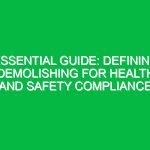Introduction
In today’s safety-conscious environment, understanding danger symbols and their meanings is crucial for anyone involved in the Health, Safety, and Environment (HSE) domain. These symbols serve as universal warnings that communicate potential hazards, ensuring that individuals can make informed decisions to protect themselves and others. This article dives deep into the significance of these danger symbols, exploring their meanings, applications, and the regulations that govern their use. By familiarizing yourself with these symbols, you can enhance safety measures in your workplace and daily life.
Understanding Danger Symbols and Their Importance
Danger symbols are graphical representations that convey potential risks in various environments, particularly industrial and workplace settings. They are designed to be easily recognizable and understood, transcending language barriers. The effective use of these symbols can help prevent accidents, injuries, and even fatalities.
The relevance of danger symbols in the HSE context cannot be overstated. They serve several important functions:
- Risk Communication: They provide clear information about the nature of hazards present in a specific area or related to a specific substance.
- Preventive Measures: By identifying risks, these symbols help in implementing necessary precautions to mitigate them.
- Legal Compliance: Adhering to regulations that mandate the use of danger symbols can protect organizations from legal liabilities.
In this article, we will explore various danger symbols, their meanings, and how they can be effectively utilized to promote safety.
Common Danger Symbols and Their Meanings
Understanding the most prevalent danger symbols is essential for anyone working in HSE. Here are some critical symbols and their meanings:
Chemical Hazards
- Skull and Crossbones: This symbol indicates toxic substances that may cause serious harm or death if inhaled, ingested, or absorbed through the skin. For instance, certain pesticides or heavy metals often carry this warning.
- Corrosive: Represented by a symbol showing a substance destroying a hand and a surface, this warns of materials that can cause severe skin burns or eye damage, such as strong acids or bases.
Physical Hazards
- Flame: Signifying flammable materials, this symbol alerts individuals to the presence of substances that can easily ignite, including gases and liquids.
- Radiation: A trefoil symbol warns of radioactive materials that can pose serious health risks. Awareness of this symbol is vital in industries like healthcare and nuclear energy.
Environmental Hazards
- Dead Fish and Tree: This symbol indicates a hazardous material that poses a threat to aquatic life and the environment, often linked to oil spills or chemical runoffs.
- Biohazard: A symbol depicting three interlocking circles warns of biological substances that pose a threat to the health of living organisms, particularly in medical and laboratory settings.
Potential Hazards and Safety Considerations
Each danger symbol carries significant implications for safety and health. Understanding these implications helps in developing effective risk management strategies. For example, when dealing with toxic substances, it is essential to have appropriate personal protective equipment (PPE) available, such as gloves and masks.
In a recent case, an industrial facility failed to properly display hazard symbols, which resulted in employees unknowingly working with corrosive chemicals. The absence of clear warning signs led to several incidents of skin burns, ultimately resulting in costly legal ramifications and a damaged reputation. This scenario underscores the necessity of proper labeling and awareness of danger symbols.
Best Practices for Implementing Danger Symbols
To maximize the effectiveness of danger symbols, organizations should consider the following best practices:
- Regular Training: Conduct regular training sessions for employees to familiarize them with danger symbols and their meanings. This can be achieved through workshops, e-learning modules, or safety drills.
- Clear Signage: Ensure that all danger symbols are displayed prominently in areas where hazards exist. This includes using high-visibility materials that can be easily seen and understood.
- Regular Audits: Regularly audit workplace safety measures and signage to ensure compliance with current regulations and best practices. This can help identify areas for improvement.
Regulations and Standards Governing Danger Symbols
The use of danger symbols is governed by various regulations and standards aimed at protecting workers and the environment. In the United States, the Occupational Safety and Health Administration (OSHA) sets forth standards that require the use of hazard communication symbols in workplaces handling hazardous materials.
Similarly, the Globally Harmonized System of Classification and Labelling of Chemicals (GHS) provides a framework for hazard classification and communication internationally. Compliance with these regulations not only enhances safety but also ensures that organizations avoid legal penalties.
Real-life Examples and Case Studies
Let’s delve into a few real-life examples that highlight the importance of danger symbols in the HSE context.
Case Study 1: Chemical Spill in a Manufacturing Facility
In a manufacturing plant, a chemical spill occurred due to a malfunctioning valve. Fortunately, danger symbols were prominently displayed throughout the facility, alerting workers to the presence of hazardous materials. Employees quickly donned their PPE and followed established emergency procedures, preventing injuries and minimizing environmental impact. This incident illustrates how effective communication through danger symbols can save lives and protect the environment.
Case Study 2: Construction Site Safety
On a construction site, the absence of proper signage regarding falling hazards led to several near-misses. After an assessment, the site manager implemented strict signage protocols, including danger symbols for overhead work. Following these changes, incidents of falls significantly decreased, proving the effectiveness of clear communication in enhancing safety measures.
Conclusion
In conclusion, understanding danger symbols and their meanings is vital for promoting health, safety, and environmental sustainability. These symbols act as crucial tools in risk communication, helping individuals recognize and respond to potential hazards effectively. By implementing best practices, adhering to regulations, and learning from real-life examples, organizations can foster a culture of safety that protects their employees and the environment.
As we move forward, let us remain vigilant in our commitment to safety. Familiarize yourself with danger symbols, advocate for clear signage, and participate in training programs. Together, we can create safer workplaces and communities, ensuring that everyone stays safe today and in the future.


